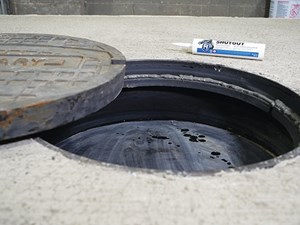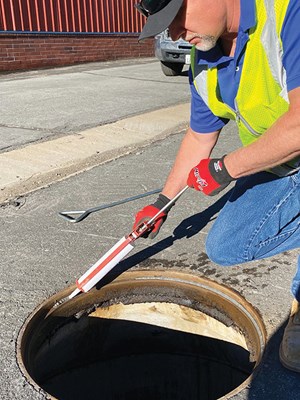October 2023 Vol. 78 No.10
Features
Innovative solution for managing I&I challenges in sanitary districts
Tim Nichols
(UI) — A major challenge sanitary districts everywhere face is recurring and growing inflow and infiltration (I&I), from substantial amounts of groundwater and stormwater entering the sewer during periods of heavy rain. This issue is of paramount importance, as heavy rainfall can cause the intrusion of large volumes of groundwater and stormwater into the sewer system, overwhelming pump stations and treatment plants, and even causing costly sewer overflows.
The Truckee Sanitary District (TSD), Calif., is the public agency responsible for collecting and conveying wastewater in the greater Truckee area outside Lake Tahoe, Calif. Serving a population of approximately 25,000 people in a 39-square-mile service area, the TSD collection system contains about 200 miles of sewer mains, 16,000 laterals and 43 lift stations.
Although the TSD sanitary sewer system is designed to convey a large amount of wastewater, it still saw significant and problematic spikes in flows during rain events – despite best efforts and use of all available technology.
“The spikes in flows happened almost concurrently with rain events,” said Blake Tresan, TSD general manager and chief engineer. “It would rain, and data from our real-time flow meters would almost immediately indicate a spike in flows. As soon as the rainstorm ended, the flows would quickly go back to normal levels.”
According to Tresan, the water was not infiltrating through the system’s pipes for the simple reason that they were buried six feet underground. If that were the main route, he notes, “It would take much longer for that rainwater to get there.”
Also, if the I&I flow would have been coming through the buried portion of the pipe and manhole network, the flow increase would have been delayed until groundwater levels had increased. In addition, I&I would have continued after the rain event until groundwater levels subsided.
The conclusion was that the I&I flow appeared to be coming through parts of the collection system exposed to surface run-off.
“The only place where the sewer system meets the ground surface is at the top of manholes and lateral cleanouts,” said Tresan, “so we decided to zero in on the manholes as a likely source of I&I.”
Manhole lubricant, sealant
In 2021, Oatey Co. and TSD joined forces to create Hercules Shutout, a manhole lubricant and sealant.
After experimenting with various products, the TSD team knew it was on to something when it applied a pipe-joint lubricant to the manhole frame – and it actually worked.
From there, TSD considered developing its own product, but ultimately decided to partner with Oatey to repurpose its solution for sewer-related applications. By submitting the I&I solution on Oatey’s Idea Portal, TSD was able to work with the manufacturer and create a nontoxic sealant/lubricant that could be applied to manhole frames: Hercules Shutout Manhole Lubricant and Sealant.
Shutout is a safe, job-site-ready solution compatible with most manhole installations. It is designed to enhance existing seals by filling voids and defects within the manhole cover and seat.
The product creates a water barrier between surfaces, reducing the likelihood of corrosion and lubricating the manhole cover to allow for easier and safer removal. It is easy to transport and requires no measurements or pre-planning. It can be applied easily with minimal surface preparation. (Oatey advises monitoring the inflow and reapplying Shutout, as needed. Shutout is not compatible with revolutionary access design and some t-gasket manhole installations.)
Another challenge, test
Recognizing the potential of this innovative solution, Keystone Consulting Engineers (KCE), an engineering firm based in Allentown, Penn., decided to use the product with its municipal clients. KCE represents many municipalities in the Greater Lehigh Valley and Pocono Regions.
In Upper Macungie Township (UMT), Penn., the ongoing challenge of managing I&I has been a top priority since the 1990s. UMT has invested considerable time and resources into identifying and rehabilitating sources of I&I. Despite implementing various rehabilitation methods, such as inflow dishes, lid/casting replacements, epoxy linings and pipe rehabilitation, UMT continues to face peak-flow issues during periods of intense rainfall.
In collaboration with its clients, who collectively own and operate over 3,800 manholes, KCE designed an experiment utilizing two “micro-basins” located in older and wetter areas of UMT. One basin was designated for rehabilitation, while the other served as the control. Each manhole and lateral in these basins was equipped with temporary meters to monitor the extent of I&I.
The study’s results provided valuable insights into the effectiveness of Hercules Shutout in reducing inflow during heavy rainfall events. Initially, during the pre-rehab rainfall on April 18-19, 2022, Allentown experienced approximately 1.7 inches of rain over 10 hours, with intermittent bouts of intense rainfall during this period. Remarkably, the meters indicated that both the control and rehab basins performed similarly, highlighting the persistence of peak flow issues despite previous rehabilitation efforts.
The true impact of Shutout became evident during the post-rehab rainfall several weeks later. Over a span of 40 hours, on May 6–7, Allentown received around 2.6 inches of rain, evenly distributed throughout this period. In this instance, nine manholes were caulked with Hercules Shutout, resulting in a significant reduction of peak flow, ranging from 0.050 to 0.100 million gallons per day (mgd) or 3.9 to 7.7 gallons per minute (gpm) per manhole.
Encouraged by these positive results, KCE conducted a hypothetical analysis to evaluate the potential benefits Hercules Shutout could provide its clients on a larger scale. Assuming only 10 percent of the 3,800 manholes experienced significant inflow averaging 5 gpm, the overall reduction in flow would amount to an impressive 1,900 gpm, or 2.74 mgd during peak flow contributions.
The case study on the utilization of Hercules Shutout in Upper Macungie Township underscores its efficacy in significantly reducing inflow and infiltration. By addressing the root cause of the problem and providing a durable and efficient sealant, the solution has demonstrated its potential to mitigate I&I-associated challenges.
This innovative solution not only contributes to the overall resilience of the sewer system, but also helps prevent costly overflow incidents, safeguarding both public health and the environment.
ABOUT THE AUTHOR: Tim Nichols is National Sales Manager-Specialty Divisions at Oatey Co.
FOR MORE INFORMATION:
Oatey, 800-321-9532, oatey.com






Comments